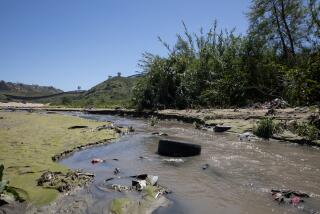Newport Channel’s Toxic Sediment: Survey Will Get to the Bottom of It
- Share via
Rhine Channel in Newport Bay presents a perfect postcard scene of weathered boardwalks, gleaming yachts and gently bobbing sailboats.
But below the scenic surface lurks one of the most toxic sites in the region. A local environmental group is hoping to determine the extent of the problem with the most comprehensive pollution survey ever conducted at the popular inlet.
“You can’t fix it until you know how it is broken,” said Garry Brown, executive director of Orange County Coastkeeper, which Friday kicked off the $346,000 effort with a ceremony by the channel.
The group recently finished a preliminary mapping of the underwater landscape with a side-scanning and sonar machine.
Now volunteers will begin extracting samples of channel sediment to test for the presence of metals and such chemicals as PCB and DDT.
“We will dig until we find clean sediment,” Brown said.
The layers of extracted sand and earth are expected also to be a lesson in history. Rhine Channel, in the west end of Lower Newport Bay, was once the center of Newport Beach’s bustling fishery with trawlers hauling mackerel and sardines to the area’s canneries.
Before that, the channel was the site of a World War II shipyard that launched more than 250 minesweepers and PT boats.
The shipyards and canneries have been replaced by restaurants and shops, but the legacy of marine industry lurks at the bottom of the channel.
The pollution was exacerbated by decades of development throughout Orange County, which dumped unknown amounts of urban runoff into the bay.
In 1998, the Santa Ana Regional Water Quality Control Board, which develops and enforces state water quality laws, deemed Rhine Channel the most toxic hot spot in Orange County.
Earlier studies found high levels of mercury; copper; zinc; polychlorinated biphenyl, or PCB; and DDE, a toxin that is formed by the breakdown of DDT.
PCB is found in electrical equipment, and DDT is a banned pesticide that has persisted in the environment from previous wide use.
Environmentalists and local officials worry that although the pollution is mostly contained in the sediments, there is growing evidence that it is seeping into the wider ocean environment.
In April, the Orange County Heath Care Agency announced that it found potentially dangerous levels of PCBs and DDT in fish caught in Newport Bay.
Because the area is popular with recreational anglers, said Ray Hiemstra, Coastkeeper’s project manager, the pollution “represents a real risk for the people who recreate and live around the bay.”
Pollution in Rhine Channel and the wider bay has been a concern for many years, but securing funds for studies and cleanup has been a challenge.
The Coastkeeper program is being funded by $278,000 of Proposition 13 money. The state measure, passed in 2000, created a $695-million bond to finance a wide range of water quality projects.
The $68,000 balance will come from the city of Newport Beach, which intends to redevelop the area around Rhine Channel and is worried about construction stirring up polluted sediments.
The study should be completed by March, Brown said. The group also will assemble environmental scientists to study the results and make recommendations for a cleanup program.
California Environmental Protection Agency Secretary Terry Tamminen, who attended Friday’s event, said the study could serve as a model for cleanup efforts elsewhere in the state.
The survey will allow for more targeted cleanup, Tamminen said, rather than a wholesale dredging of the inlet, which could cost tens of millions of dollars.
Earlier in the day, those who gathered for the event got a glimpse of the channel’s murky bottom.
Randy Seton, Coastkeeper’s media director, used an underwater camera to scan the underwater landscape. The lens was attached to a long pole, and a monitor displayed a field of debris.
Seton said divers found shopping carts and traffic signs when they combed the channel five years ago to kick off Coastkeeper’s founding.
As he spoke, a bird carcass floated nearby.
“The stuff we are worried about,” Seton said, “is the stuff we can’t see.”
More to Read
Sign up for Essential California
The most important California stories and recommendations in your inbox every morning.
You may occasionally receive promotional content from the Los Angeles Times.









